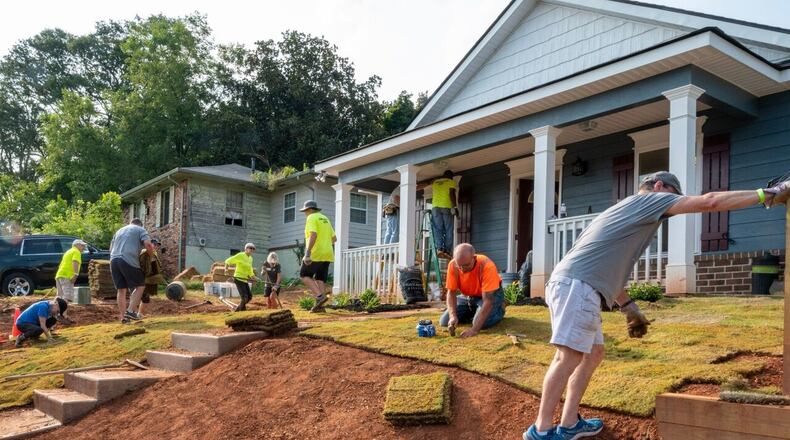As Atlanta City Council prepares to vote on sweeping changes to the city’s Tree Protection Ordinance (TPO), Atlanta stands at a critical crossroads.
In its current form, the proposed ordinance aiming to protect the tree canopy introduces risk for all Atlantans — those in need of affordable, attainable homes and everyone seeking housing in vibrant, walkable neighborhoods with mixed-use and retail opportunities supporting communities.
We share pride in Atlanta’s “City in the Forest” identity. We agree that the tree canopy is a vital resource providing shade, mitigating heat and helping manage stormwater. We urge policymakers, however, to ensure that new regulations do not inadvertently undermine Atlanta’s equally urgent need for affordable and market-rate housing, economic growth and equitable development.
New requirements — especially mandatory conservation areas in every new development, regardless of site context or project type — and higher recompense fees-will drive up costs, significantly reduce the number of homes that can be built, undermine the ability to serve families earning between 30 and 80% of the area median income and render many affordable projects infeasible.
The impact doesn’t stop there. These same requirements will also limit the creation of market-rate housing options like duplexes, townhouses and apartments above storefronts, the very types of homes that help create walkable, mixed-use neighborhoods that Atlantans increasingly desire.
This is not just a theoretical concern: Real projects serving real families will be lost if these provisions move forward unchanged. Under the proposed rules, Atlanta Habitat for Humanity’s Browns Mill Village project, for example, would shrink from 138 to just 81 homes, with per-lot costs soaring beyond the reach of working families. Similar impacts would have eliminated 40% of another key workforce housing community, Springside Place. Meanwhile, the supply of market-rate homes, crucial for meeting demand and keeping prices in check, would also be constrained, making it harder for Atlantans to find attainable housing in the neighborhoods where they want to live.
We support raising tree removal fees to better reflect the true cost of tree replacement, but the proposed increases are dramatic and, for many projects, uncapped. The revised waiver criteria for affordable housing are so restrictive that very few projects will qualify for meaningful relief. This undermines the city’s own affordable housing goals and risks exacerbating Atlanta’s housing crisis. It also raises costs for market-rate projects, making it harder to deliver the housing all residents are seeking.
The ordinance dramatically impacts development by requiring site area preservation on all types of properties, not just single-family homes. All commercial, including retail, office, industrial, townhome and apartment properties, will be severely impacted with up to 40% of site areas mandated as preserved tree save areas in some cases. The permanent preservation standard includes redevelopment sites that have no trees. This blanket approach does not account for the diversity of Atlanta’s neighborhoods or the practical realities of redevelopment, especially on sites already lacking significant tree cover.
We have repeatedly called for thorough project testing in concert with the adoption of Zoning 2.0 and phased implementation to ensure new rules do not have unintended, counterproductive effects. Rushing to enact the ordinance without this due diligence risks stalling or stopping urgently needed housing, both affordable and market-rate, and commercial projects, including retail, office, industrial and multifamily, that support Atlanta’s growth and economic vitality. As we consider changes to the ordinance, we must do so with an understanding of how it fits into the broader regulatory landscape and the real-world consequences for housing affordability and choices in our city.
Credit: Chris Ahrenkiel/contributed
Credit: Chris Ahrenkiel/contributed
Credit: Jim Cheeks/contributed
Credit: Jim Cheeks/contributed
Credit: Aiva Genys
Credit: Aiva Genys
Credit: Rosalyn Merrick/contributed
Credit: Rosalyn Merrick/contributed
Atlanta is not alone in facing the challenge of balancing tree protection with housing needs. Across the country, cities are finding ways to protect their urban forests while advancing both affordability and market-rate housing. For example, it is reported that Seattle has moved beyond the trees vs. housing debate, explicitly integrating tree preservation, climate resiliency and affordable and market-rate housing into a unified policy framework. Columbus, Ohio, targets tree investments in neighborhoods with the lowest canopy and highest vulnerability, using data to drive outcomes, prioritizing preservation and replanting in communities most in need. And many cities phase in major changes and pilot them on real projects to identify unintended consequences before citywide adoption.
Atlanta’s future depends on its ability to balance growth and sustainability. We commend the many passionate tree proponents in our community and are eager to continue to help craft an ordinance that preserves our urban forest while also ensuring that all Atlantans — especially those most in need — can afford to call this city home. With a balanced, innovative approach, Atlanta can protect its iconic canopy and remain the “City in the Forest” for generations to come while also fostering the walkable, vibrant neighborhoods that residents want and deserve.
Chris Ahrenkiel is executive vice president at Selig Enterprises and President at the Atlanta Commercial Board of Realtors
Jim Cheeks is president at Fortress Homes and board member of the Homebuilders Association
Paul Corley is regional president at Empire Communities and former chairman of Council for Quality Growth
Rosalyn Merrick is president and CEO of Atlanta Habitat for Humanity
About the Author
Keep Reading
The Latest
Featured





